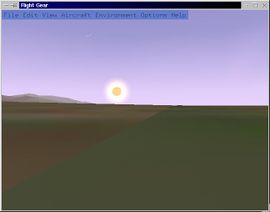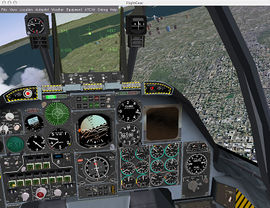FlightGear history
FlightGear development started with an online proposal in 1996, using custom 3D graphics code. Development of an OpenGL based version was spearheaded by Curtis Olson starting in 1997. Many people have contributed to the project in the years since its inception.
FlightGear incorporated other open-source resources, including the LaRCsim flight model from NASA, and freely available elevation data. The first working binaries, using OpenGL for 3D graphic code, came out in 1997. Enthusiastic development of newer versions for several years resulted in progressively more stable and advanced versions. By 2001, the team was releasing new beta versions regularly, and by 2005, the maturity of software lead to more widespread reviews, and increased popularity. 2007 marked a formal transition out of beta development with the release of version 1.0.0, ten years after FlightGear's first release in 1997.
In 2008, version 1.9.0 of FlightGear included a major change from PLIB to OSG, which caused the temporarily loss of some features like 3D clouds and shadows, while newly added features, such as particles, imparted another degree of realism to the simulation.
Beginnings (1996-1997)

The FlightGear project was conceived on April 8, 1996 by David Murr who proposed a new flight simulator to be developed by volunteers[1][2][3][4]. Part of the initial goals were to develop 2D and 3D graphics routines for the simulator. However this was a huge task that came to an unfinished halt at the start of 1997 as the main developer, Eric Korpela, was finishing his thesis.
Development of an OpenGL based version was spearheaded by Curtis Olsen starting in 1997, after the initial start in 1996. A large community response lead to many contributing to the project from its start in late '90s up to the present.
"I was working at the University of Minnesota at the time, and had access to Sun and SGI graphical work stations which offered OpenGL for 3d graphics. OpenGl was just starting to become available on PC hardware with things like the 3dfx voodoo card. Somewhere at this point it occurred to me that a far better path would be to leverage an existing multi-platform 3d graphics system (like OpenGL) to build our flight simulator upon.
So I proceeded to rough together a basic scenery system, pasted on the larcsim flight model, and in a relatively short time was able to show actual flight over real 3d terrain. Good, realistic 3d terrain was something the other existing flight sims at the time were pretty far behind on ... and I think my work was enough of a breakthrough that it got a lot of people excited about the possibilities."~Curt Olson [5]
Rather than start entirely from scratch, FlightGear developers made use of the LaRCsim flight model from NASA, with OpenGL for 3D graphic code, and freely available elevation data. First working binaries came out in 1997, with an intense updating of newer versions for several years resulting in progressively more stable and advanced programs.
Versions 0.7–0.9 (2001–2003)
By 2001, the team was releasing new beta versions regularly (0.7.x, 0.8.0, over 2001-2003) and with 0.9.xx (2003-2006). Later in the decade, the rate of final public releases slowed, but had larger amounts of content (0.9.10, 1.0.0 etc.). The maturity of software by 2005 lead to more widespread reviews, and increased popularity.
Version 0.9.0-0.9.11 (2002-2007)
The use of version numbers slowed dramatically after the late 2002 release of version 0.9.0. Versions 0.9.9 (2005) and 0.9.10 (2006) had about 8 all-new or redone aircraft adding to a total of 70-90 aircraft. Nasal was also integrated into FlightGear in version 0.9.4. FlightGear 0.9.10 won Softpedia's "Pick" award (5 out of 5 stars) on June 3, 2006 as well as the "100% CLEAN" Softpedia award.
Behind the scenes there was a 0.9.11-pre1 released in 2007 that ended up being superseded by FlightGear 1.0. The pre-version had about 33 new or redone aircraft.

Version 1.0 (2008)
The version number marked a formal transition out of beta development since the software's first release in 1997, ten years prior.
Version 1.9.0 (2008)
At the time version 1.9.0 was released FlightGear switched from PLIB to OSG, which caused the temporary loss of some of the features like 3D clouds and shadows. On the contrary new features such as particles add another degree of realism to the simulation. Most aircraft developed for OSG do not work with older versions. The user is able to choose from 230 aircraft provided with 1.9.0, although only a few are included in the base package. Version 1.9.1, released shortly afterwards, was a bug fix release.
Version 2.0.0 (2010)
FlightGear 2.0.0 reflects the maturation of the OpenSceneGraph port that started with the previous 1.9.0 release. In addition to many internal code improvements, FlightGear 2.0.0 marks the introduction of many new exciting improvements in the graphics and sound system, as well as improved usability of key features, and improved behavior of existing features. Highlights of this new version include: Dramatic new 3D clouds, dramatic lighting conditions, improved support for custom scenery, and many many new and detailed aircraft models.
Version 2.4.0 (2011)
Starting with version 2.4.0, the FlightGear team adopted a release plan. From then on, a new version is released every February and August.
Version 3.8.0/2016.1.0
|
|
Following the cancellation of 3.6, the modern FlightGear team revised the release plan and process. New releases are essentially selected and tuned "nightlies" instead of special compilations.
Also, in this release the concept of rotating default airports first started. All FlightGear releases after 2016.1 have unique default airports and 'codenames'.
|
|
Release timeline
Final build code release dates by year.
| Date | Version |
|---|---|
| Jul 17, 1997 | First major code release |
| Sep 23, 1997 | 0.12 |
| Dec 9, 1997 | 0.15 |
| Dec 17, 1997 | 0.18 |
| Dec 30, 1997 | 0.19 (first binaries) |
| Jan 6, 1998 | 0.22 |
| Mar 11 98 | 0.37 |
| Apr 8, 1998 | 0.41 |
| Apr 14, 1998 | 0.42 |
| Apr 23, 1998 | 0.43 |
| Apr 28, 1998 | 0.44 |
| May 7, 1998 | 0.45 |
| May 11, 1998 | 0.46 |
| May 18, 1998 | 0.47 |
| Jun 9, 1998 | 0.48 |
| Jun 27, 1998 | 0.49 |
| Jul 13, 1998 | 0.50 |
| Jul 21, 1998 | 0.51 |
| Aug 15, 1998 | 0.52 |
| Sep 2, 1998 | 0.53 |
| Sep 25, 1998 | 0.54 |
| Oct 23, 1998 | 0.55 |
| Nov 23, 1998 | 0.56 |
| Jan 21, 1999 | 0.57 |
| Feb 10, 1999 | 0.58 |
| Mar 31, 1999 | 0.59 |
| May 26, 1999 | 0.6.0 |
| Jun 21, 1999 | 0.6.1 (Stable) |
| Sep 11, 1999 | 0.7.0 (Development) |
| 0.6.2 (Stable) | |
| Oct 22, 1999 | 0.7.1 (Development) |
| Feb 17, 2000 | 0.7.2 (Development) |
| May 18, 2000 | 0.7.3 (Development) |
| Jul 20, 2000 | 0.7.4 |
| Sep 18, 2000 | 0.7.5 |
| Dec 19, 2000 | 0.7.6 |
| Jun 20, 2001 | 0.7.7 |
| Jul 13, 2001 | 0.7.8 |
| Feb 16, 2002 | 0.7.9 |
| Apr 20, 2002 | 0.7.10 |
| Sep 7, 2002 | 0.8.0 |
| Dec 3, 2002 | 0.9.0 |
| Dec 5, 2002 | 0.9.1 |
| Jun 4, 2003 | 0.9.2 |
| Oct 24, 2003 | 0.9.3 |
| Mar 26, 2004 | 0.9.4 |
| Jul 29, 2004 | 0.9.5 |
| Oct 12, 2004 | 0.9.6 |
| Jan 18, 2005 | 0.9.8 |
| Nov 17, 2005 | 0.9.9 |
| Apr 5, 2006 | 0.9.10 |
| May 2007 | 0.9.11-pre1 |
| Dec 17, 2007 | 1.0.0 |
| Dec 22, 2008 | 1.9.0 |
| Jan 25, 2009 | 1.9.1 |
| Feb 25, 2010 | 2.0.0 |
| Aug 17, 2011 | 2.4.0 |
| Feb 17, 2012 | 2.6.0 |
| Aug 17, 2012 | 2.8.0 |
| Feb 17, 2013 | 2.10 |
| Sep 21, 2013 | 2.12 |
| Feb 17, 2014 | 3.0 |
| Oct 15, 2014 | 3.2 |
| Feb 17, 2015 | 3.4 |
| N/A | 3.6 (unreleased, see here) |
| Feb 17, 2016 | 2016.1.1 (new versioning scheme) |
| May 7, 2016 | 2016.1.2 |
| May 17, 2016 | 2016.2.1 |
| Sep 12, 2016 | 2016.3.1 |
| Nov 19, 2016 | 2016.4.1 |
| Nov 23, 2016 | 2016.4.2 |
| Dec 5, 2016 | 2016.4.3 |
| Dec 28, 2016 | 2016.4.4 |
| Feb 23, 2017 | 2017.1.1 |
| Mar 1, 2017 | 2017.1.2 |
| Apr 4, 2017 | 2017.1.3 |
| May 22, 2017 | 2017.2.1 |
| Sep 20, 2017 | 2017.3.1 |
| Apr 11, 2018 | 2018.1.1 |
| May 22, 2018 | 2018.2.1 |
| Dec 3, 2018 | 2018.3.1 |
| Jan 29, 2019 | 2018.3.2 |
| N/A | 2018.3.3 (not released) |
| Aug 9, 2019 | 2018.3.4 |
| Apr 20, 2020 | 2018.3.5 |
| Aug 9, 2020 | 2018.3.6 |
| Mar 14, 2019 | 2019.1.1 |
| Sep 1, 2019 | 2019.1.2 |
| May 11, 2020 | 2020.1.1 |
| May 25, 2020 | 2020.1.2 |
| Jun 26, 2020 | 2020.1.3 |
| Oct 13, 2020 | 2020.2.1 |
| Oct 29, 2020 | 2020.3.1 |
| Nov 6, 2020 | 2020.3.2 |
| Nov 23, 2020 | 2020.3.3 |
| Dec 1, 2020 | 2020.3.4 |
| Dec 19, 2020 | 2020.3.5 |
| Jan 24, 2021 | 2020.3.6 |
| Mar 21, 2021 | 2020.3.7 |
| Mar 25, 2021 | 2020.3.8 |
| Jun 14, 2021 | 2020.3.9 |
| Jul 26, 2021 | 2020.3.10 |
| Jul 29, 2021 | 2020.3.11 |
| Feb 6, 2022 | 2020.3.12 |
| Mar 30, 2022 | 2020.3.13 |
| Sep 27, 2022 | 2020.3.14 |
| Oct 12, 2022 | 2020.3.15 |
| Oct 20, 2022 | 2020.3.16 |
| Sep 22, 2022 | 2020.3.17 |
| Mar 21, 2023 | 2020.3.18 |
Cycled default airports
FlightGear did not start changing the default airport until version 2016.1 was released. At that time, the idea was that each new release would have a new default airport. This chart lists the default airports since 2016.1 was released. Since 2018.1, the selection of a new default airport has been changed so that a new airport is selected for each new major version release instead of for each minor version release.
| Release | ICAO | Default Airport |
|---|---|---|
| 2016.1 | KSFO | San Francisco (transition) |
| 2016.2 | LEBL | Barcelona |
| 2016.3 | SBRJ | Rio de Janeiro |
| 2016.4 | LSZH | Zürich |
| 2017.1 | ENBR | Bergen |
| 2017.2 | KBOS | Boston |
| 2017.3 | LKPR | Prague |
| 2018.1 | PHNL | Honolulu |
| 2018.2 | ||
| 2018.3 | ||
| 2019.1 | ||
| 2020.1 | BIKF | Keflavik |
| 2020.2 | ||
| 2020.3 |
External links
- Internet Archive: Wayback Machine for http://www.flightgear.org/
- Old website on December 5, 1998
- link ("A view from the ground near Tucson, AZ (KTUS)", old FlightGear screenshot)
- link ("Here's one of the Grand Canyon with a rock face texture. I know this looks funny, but I'm just experimenting here.", old FlightGear screenshot)
References
|
